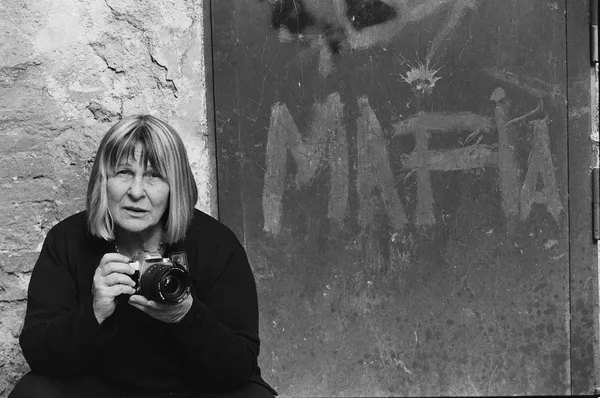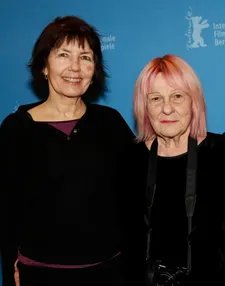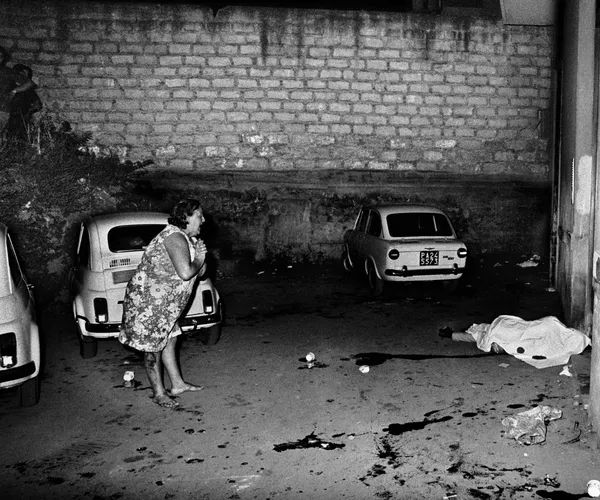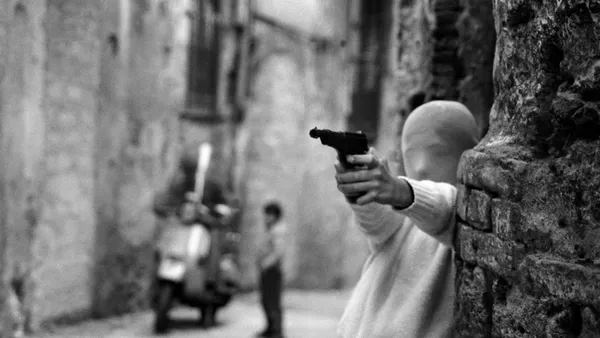 |
| Letizia Battaglia. Ollie Huddleston: 'We wanted it to be an emotional journey – that you feel like you’re going through someone’s life.' Photo: Shobha/Lunar Pictures |
Documentarian Kim Longinotto blends first-person testimony with archive in her latest film Shooting The Mafia – which premiered at Sundance before heading to Berlin last month. The film, edited by her long-time collaborator Ollie Huddleston, offers a profile of Sicilian photojournalist Letizia Battaglia at the same time as considering the impact of the Mafia on her community – the documenting of which has been octogenarian Battaglia’s life’s work. I caught up with Longinotto and Huddleston in Sundance to talk about the film – which they refer to as “The Beast” – talking about the unique challenges of making this blend of documentary and archive and Battaglia as a kindred spirit.
Amber Wilkinson: It is quite a departure for you to do an archive-centred documentary – how did you come to it in the first place?
 |
| Kim Longinotto and Letizia Battaglia. Kim: 'I never got to tell her but the more that we found out about her, the more I realised we had in common' Photo: Courtesy of Berlin Film Festival |
Kim Longinotto: Totally. We’ve done nine observational documentaries together – if you’ve seen Dreamcatcher, you’ll know how it works – and then, at the end of that, we wanted to make an archive film about childhood. And we did a film called Love Is All: Boy, Girl, Love, which is a purely archive film from the BFI archive and then with music.
It was so easy, it took seven or eight weeks. It was like a sort of series of little pop promos. We were slightly over-confident because we had no idea how difficult it is.
Ollie Huddleston: I remember on the way back from Dreamcatcher here at Sundance, literally at Salt Lake City airport, saying, ‘Why don’t we just mix the two? Let’s do Love Is All joined up with Dreamcatcher’. But, actually, when you try to do it, it’s incredibly difficult. Just marrying all those different energies and forces and flavours. It’s great, because it’s fresh, but it wasn’t easy.
KL: Also, if you think someone Letizia’s age – she’s 87 – there was so little archive of her. When we started, there was nothing to cut. Then we got these two archivists, who are the heroes of the piece. But there was some archive that we only got in after a year and a half, so we had no idea, because when we did that for the BFI, of course it was all there.
OH: Also with the Mafia, there’s not a lot of footage. You get people being arrested – there’s the big court case in the middle – but mostly what you get if you’re lucky, or if you’re unlucky, is bodies murdered in the streets.
KL: What we wanted to get was the sense of ordinary people living through it, and that you never see. So people on the streets, because that’s what most of Letizia’s photos are about, they’re about the effect it has living there. It’s kind of like saying to people, ‘Look, you’ve all grown up watching The Godfather, everybody watches these heist movies and we all watch shoot-em ups but in those films, none of it’s real.’ You suddenly realise quite early that they brutalised and traumatised a whole nation. They weren’t glamorous guys in suits, they were nasty, little, often illiterate and desperate, shameless people, who had this weird code that meant that they were okay because they were ‘men of honour’. It meant they could blow up whole roads and kill 40 people. They’re like nasty little terrorists. I don’t call people terrorists normally because they’re usually working for some sort of ideal but all these people are out for his themselves, money and power.
AW: In terms of Letizia. When you decided you were going to do a combination of archive and your more regular set-ups, did you then go looking for a subject or did you have her in mind?
KL: That was a coincidence. My producer Niamh Fagan went to Italy and met Letizia. She set the whole thing up because she went to this little museum in Corleone and saw her photos and then she got in touch with Letizia and asked if we could make the film. Normally, I might not have said I would do it but it was because we’d been talking about doing it. But if I’d known how hard it was going to be – nine months’ editing, we usually do it in ten weeks.
 |
| Ollie Huddleston: 'What we wanted to get was the sense of ordinary people living through it, and that you never see' Photo: Letizia Battaglia/Lunar Pictures |
AW: I suppose you’re usually in such a groove with what you’re doing after all these years, because you don’t normally shoot a lot of footage. So, to suddenly have an archive to work with must have been difficult.
OH: Also, when we watched stuff, it felt like the story hadn’t been told properly. When I say properly, we were trying to make it as much an experience as one of Kim’s observational films would be, so we would ask the researchers to find footage that Kim might have shot had she been there – so fly on the wall, verité style. That’s the problem with archive. People just take shots, put a bit of interview in or stuff music all over it. You don’t really get a sense of any sequences and if you don’t have a sequence you don’t have an experience. So, for example, the black and white scene when she’s taking photographs of the murdered judge in the car with the shattered window around him, there’s a set of ten or 15 shots which last for four or five minutes when you actually are there and she can tell you about her experience. Without experiences like that, it’s really hard.
AW: When you were structuring this, did you have the interview when you went in with the archive or did you have it as a two-track thing that then had to be melded together?
OH: We did it as a two-track thing but the backbone of the film was three weeks that Kim shot in Palermo with Letizia, her lovers and the rally. Then, I guess, we cut that down but we were always looking for alter-egos because there wasn’t footage that was readily available and because we wanted it to be an emotional journey – that you feel like you’re going through someone’s life. We knew that we were going to use movies and we started to look for different characters who would represent her at different stages in her life.
AW: Did she sense in you a kindred spirit?
KL: I never got to tell her but the more that we found out about her, the more I realised we had in common. The thing of putting her work first, her and her dad/me and my dad, an Italian dad, absolutely similar, having to leave home really early. She got married, which was her way out. At least I was in a place where I knew that I never wanted to get married so I knew that wasn’t a way out. There’s something really sweet and naïve about it, that she thought she would get married and she would get freedom. We had all that in common – the controlling father, I grew up in an institution as well.
AW: She talks about the way that she misses the images she didn’t capture with her camera. Do you ever feel that way about documentary, that you stop the camera rolling and something happens and you miss it?
KL: The thing I most identify with her about is… Well, Ollie knows there’s been two films where I’ve filmed things that your heart tells you that you shouldn’t film. So, one [The Day I Will Never Forget] was a girl actually being circumcised and another [in Rough Aunties] was a little boy had drowned and he had just been fished out of the river and his mother was one of the people – a lovely young woman called Studla. He was her only kid, and she’s distraught and I’m filming it.
And that is exactly what Letizia is saying. I had held in this sense of shame about it and that was 2006 and when we saw the translation of Letizia, that was when I let a bit of it go – that was how long. Because, the sound recordist, Mary, in both those situations said: ‘Kim, we shouldn’t be filming this. This is wrong. Don’t film this’. I really like Mary, I’d worked with her for nearly as long as I’d worked with Ollie and I said: ‘Mary, we have to film it, that’s what we’re here for. We can decide whether to put it in the edit or not.’ But she said: ‘No, this is wrong. I’m not filming it’. When somebody says that, you really go: ‘Whoa.’
And then she wouldn’t work with me after that last one. It was as if I’d crossed some sort of boundary and I’d gone into some sort of voyeurism or some sort of lack of humanity or something. So, I really identify with Letizia saying, ‘I couldn’t take the photo of Falcone but I miss them.’ I was always pleased I did. But, at the time, just imagine this, there was this woman kneeling on the ground, weeping, I kneel on the ground and film her weeping, then I stand up and film the river where the child’s drowned and I’m thinking. ‘Kim, there’s something wrong with you that you can actually plan this like this and then thin of the next shot and be so dispassionate that I can film the scene to cut together so that Ollie can cut it’. At the same it’s my friend whose little boy has died. You become a kind of monster, I think. I suppose that’s what Letizia was talking about.
 |
| Kim Longinotto on the Mafia: 'You suddenly realise quite early that they brutalised and traumatised a whole nation' Photo: Letizia Battaglia/Lunar Pictures |
OH: I would imagine, I don’t know if this is true, but Letizia taking photos of the Mafia murders and you taking pictures of Studla, it’s slightly similar in that you’re putting the story first. You want things to change. What is happening in front of you is not right and you have to do something about it and to do that you have to sacrifice your own…
KL: Humanity
OH: Fears, humanity, whatever, to tell the story. It’s much less like that in the editing. But to do it live…
KL: It is what you’re doing and you hate yourself for it and, in a way, you don’t really forgive yourself for it. I think Letizia doesn’t forgive herself for it and that’s why she wants to burn the negatives.
AW: At the same time as missing the ones she didn’t take. It’s like she’s in a very conflicted position, wanting to destroy the images she does have but also retain the images that she doesn’t have.
KL: Exactly. That’s what’s so interesting about us human beings. We have mixed emotions. In any situation, you usually have two mixed emotions. Sometimes I can be angry that somebody’s treating me badly and feel sorry for them at the same time. That’s a really clear example. Emotions are never easy, they’re always mixed up.
AW: One thing that’s always been a strength of your documentaries, that people say things that perhaps even surprise them.
KL: I hope so. But I remember really identifying with that scene [between Letizia and a former lover], because sometimes, if I meet an ex-partner, and there’s a sense of where did all go, what was the point of it? I love it when she says that. And he says, ‘No, we’re like family’. If you have an intense love affair and then it splits up, what was it all about? Was it an illusion? So I do like all that and she comes down very strongly saying, ‘Look, my main thing is my work and I’m committed to my work’. Love is always going to disappoint you is, I suppose what she feels.
AW: And yet, Letizia has managed to pick up yet another younger lover in the process.
OH: Isn’t it fabulous. In the film, she calls herself a restless woman and, at one point, we were trying to make that the title of the film in a positive way. You know looking and searching and wanting more and pushing. Restless is not a particularly positive word, but in this instance…
KL: It means a woman who can’t settle and is disappointed.
OH: But when you meet her she’s always looking and searching for something fresh and new and real. It’s great, it’s a lovely thing.
SHOOTING THE MAFIA by Kim Longinotto (Ireland) from european film promotion on Vimeo.
AW: Has she seen the film?
KL: It was so dramatic. The first screening, our premiere, she was there and it was the first time she’d seen it. I was sitting behind her. She said she loved it.
AW: That must have been a relief for you?
KL: We were saying to each other, ‘Look, if she doesn’t like it, that’s interesting too, it’ll be interesting to see what she doesn’t like.’ Actually, it’s very difficult to think if you’re filming a life, that you would love all of it. So she’s pretty amazing.
AW:Do you think it’s got easier to work together down the years?
KL: For myself, it’s always just been a complete joy. It’s the best bit, you go away and you have the most horrible experiences, say going to Cameroon and someone gets killed, and you come back to the editing room and it’s safe. I don’t think we’ve ever had an argument.
OH: It’s really strange, because the first time I met Kim was in the edit suite. You didn’t interview me and I jumped at it because you’d just done Divorce Iranian Style, which I thought was the best documentary I’d seen in years. But the trust was there from the beginning. I can remember cutting the first sequence in Runaway. I said, ‘Kim, I’m just going to have a quick go at this.’ It was lunchtime and I just had an idea and she said, ‘Yeah.’ That element of be who you are, do your own thing, I’m with you has carried on all the way through. It’s been such fun. Kim’s really helped me find my voice.
Shooting The Mafia has been bought for distribution in the US by the Cohen Media Group. No release date has yet been set on either side of the Atlantic.





















